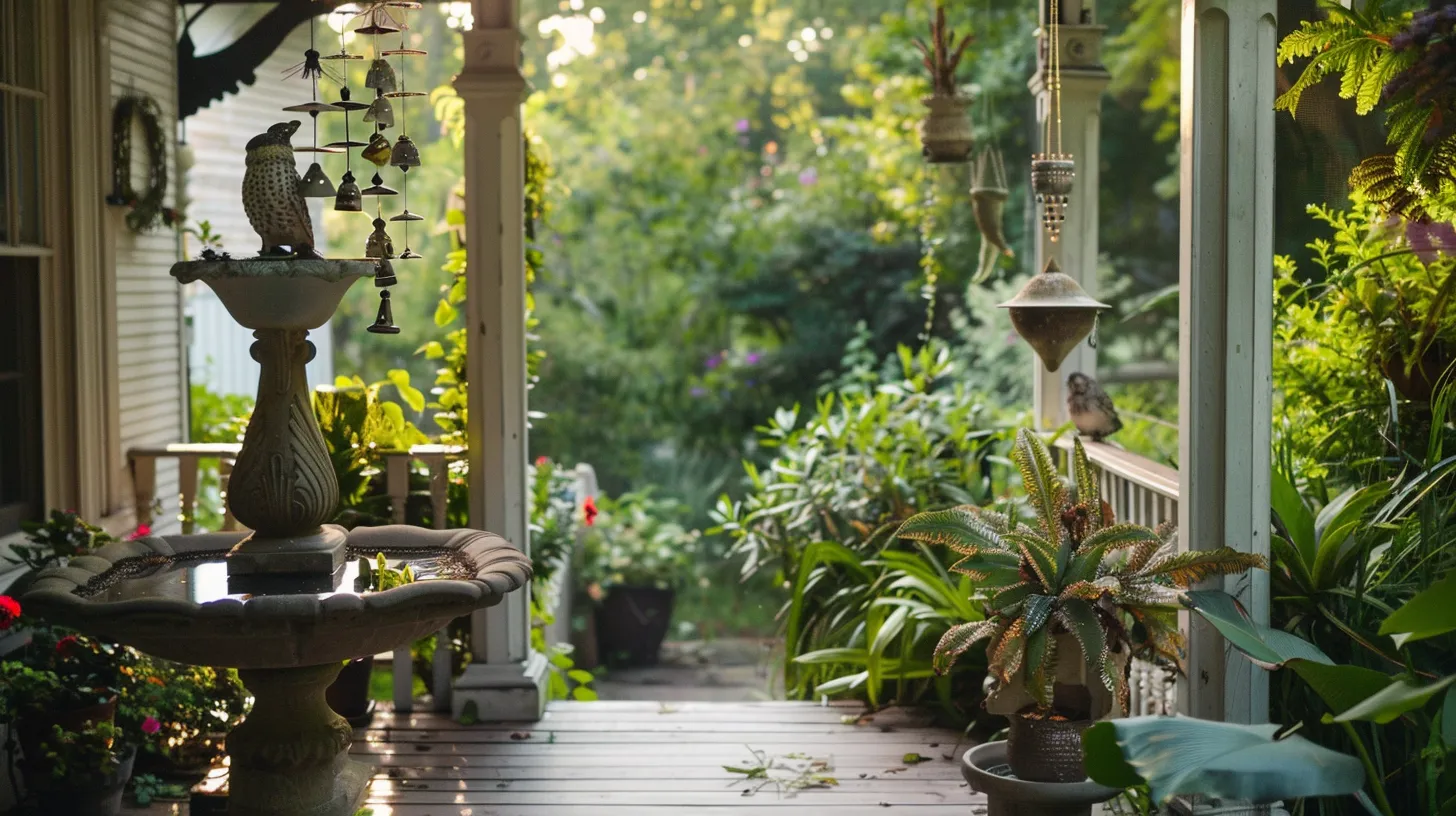Effective strategies to deter birds from your porch involve understanding their behavior and implementing a combination of techniques. Utilize thorny plants or bird spikes to discourage perching and nesting. Install visual deterrents like reflective objects or predator decoys, and auditory tools such as wind chimes or distress calls to disrupt their comfort. Regular maintenance is essential: check and adjust deterrents as needed and clean areas to eliminate food sources. Guarantee solutions are humane and legal , respecting both avian welfare and efficacy. Adopting these strategies forms a robust defense against unwelcome birds, inviting further exploration into sustainable and effective bird control methods.
Understanding Bird Behavior

To effectively deter birds from your porch, it is important to first comprehend their behavior, including their attraction to elevated areas for food and safety. Birds often view porches as prime locations due to the availability of food sources and perceived safety from predators. Understanding these motivations is essential in developing targeted deterrent strategies.
Bird behavior is complex and influenced by multiple factors. Food availability directly impacts where birds choose to congregate. If your porch inadvertently provides food, either through pet food, open garbage, or bird feeders, it becomes a magnet for avian visitors. Similarly, porches can offer ideal nesting opportunities , sheltered from elements and predators, thereby attracting nesting birds.
Additionally, understanding bird communication , flocking patterns , and territorial behaviors can enhance deterrent methods. Birds communicate danger and safe zones to others, influencing flocking patterns. By disrupting these communications through strategic deterrents, you can make your porch less appealing.
Implementing humane solutions involves creating alternative habitats that fulfill their needs for food, safety, and nesting, diverting their attention away from your porch. By aligning deterrent strategies with natural bird behavior, homeowners can effectively encourage birds to relocate, maintaining harmony between human and bird coexistence.
Natural Deterrent Techniques

Having understood bird behavior, we now explore various natural deterrent techniques that can effectively keep birds away from porches without causing them harm.
One effective method involves the use of thorny plants such as holly bushes , which create an inhospitable environment that discourages birds from nesting and roosting on your property. These plants serve as a physical barrier naturally integrated into your outdoor spaces, enhancing aesthetics while providing a humane approach to bird deterrence.
Another natural deterrent solution involves the strategic placement of predator decoys , such as models of owls or hawks. These decoys instill a sense of danger in birds, making your porch appear risky and prompting them to find safer locations. This method leverages the birds' instinctual fear of predators, thereby preventing them from settling on your porch.
Additionally, incorporating reflective objects like mirrors or using reflective tape can disorient birds by creating an unsettling visual environment . The unexpected flashes of light and distorted reflections disrupt the comfort birds seek in a landing area, effectively deterring them from approaching your porch. These reflective elements add another layer of protection by utilizing visual stimuli to keep birds at bay, ensuring your outdoor spaces remain serene and unspoiled.
Physical Barrier Implementations

Physical barrier implementations offer a robust method to deter birds from encroaching on porch areas. Bird spikes , a prevalent choice, effectively prevent birds from landing or roosting on ledges and other flat surfaces. These spikes do not harm birds but simply create an uncomfortable environment for perching .
Additionally, bird netting serves as an excellent physical barrier. Made from durable plastic mesh , it can be strategically placed to enclose porch ceilings or open areas, thereby preventing birds from accessing these spots for nesting or resting. This method is particularly useful in keeping larger areas bird-free without impacting the aesthetic appeal of the property.
Another effective solution involves the application of bird repellent gel on surfaces where birds are likely to land. The gel creates a sticky and unpleasant texture, discouraging birds from staying. For a dynamic approach, installing motion-activated sprinklers can startle and deter birds from settling on your porch. These sprinklers activate upon detecting movement, making the area less inviting.
Lastly, wire barriers like bird wire or bird coils can be used to create unstable surfaces that are unsuitable for birds to perch or build nests on. These barriers are discreet yet highly effective in maintaining a bird-free porch .
Visual and Auditory Deterrents

In addition to physical barriers, implementing visual and auditory deterrents offers another layer of protection against birds on your porch. Visual deterrents such as reflective tape and shiny objects , including CDs and foil strips, can disorient birds and effectively deter them from settling on your property. These materials reflect light and create unpredictable patterns that birds find disconcerting, making your porch less appealing.
Furthermore, the placement of fake predators like plastic owls or hawks can leverage a bird's natural fear of predators, enhancing the effectiveness of these visual deterrents. These replicas create a perceived threat environment that birds typically avoid.
Auditory deterrents also play a significant role in creating an unwelcoming atmosphere for birds. Wind chimes are particularly useful, as the constant and variable noise they produce can make the area uninviting. Additionally, the use of recorded bird distress calls can trigger an instinctual avoidance response, further discouraging birds from visiting your porch.
Combining these visual and auditory strategies not only maximizes the deterrence effect but also ensures that the solutions are humane, interfering minimally with the natural behavior of birds while effectively keeping them at bay.
Maintenance and Monitoring Strategies

To guarantee the longevity and effectiveness of bird deterrents on your porch, regular maintenance and vigilant monitoring are essential. It is important to prevent birds from nesting in areas that can cause inconvenience or damage. Conducting routine checks helps in early detection of problems , which when addressed promptly, can deter birds from the porch effectively.
Monitor bird spikes to make sure they are firmly in place and free from damage. Any signs of wear or shifting should be addressed immediately to maintain their functionality. Similarly, repair bird netting regularly to close any gaps through which birds might pass. Ensuring that the netting is intact is crucial for it to serve its purpose.
Check reflective tape and other visual deterrents for any signs of fading or deterioration. Replace visual deterrents periodically to preserve their effectiveness in keeping birds at bay. Also, keep wind chimes clean and in good working order. Properly tuned and clean chimes are more effective at producing the necessary noise to scare away birds.
Legal and Ethical Considerations

While maintaining and monitoring bird deterrents is important for effectiveness, it is equally essential to contemplate the legal and ethical implications of various bird control methods. Employing inhumane bird control techniques such as poisons, sticky gels, and avicides like Avitrol not only raises significant legal concerns but also conflicts with the ethical treatment of wildlife. Most jurisdictions strictly regulate or outright ban the use of such harsh methods due to their cruel impact on avian populations.
Moreover, ultrasonic bird repellents , which are marketed for their supposed efficacy, often fall short of expectations and do not align with humane bird control practices. Their questionable effectiveness combined with ethical considerations makes them a less favorable option for responsible homeowners.
To ensure compliance with laws and uphold ethical standards, exploring alternative, humane avian deterrent methods is crucial. These bird repellents should be effective yet benign, avoiding any harm to the birds while mitigating nuisance problems. By adopting bird control strategies that are both legal and ethical, individuals can effectively address bird-related issues on their porches without compromising the welfare of the animals. This balanced approach helps protect avian life while maintaining a bird-free environment.










